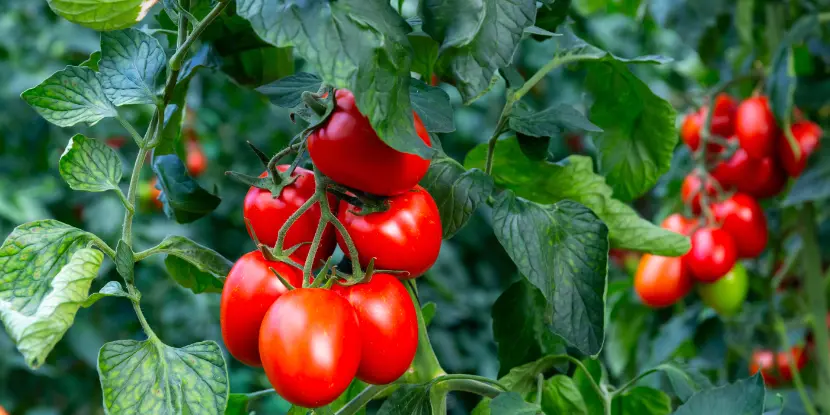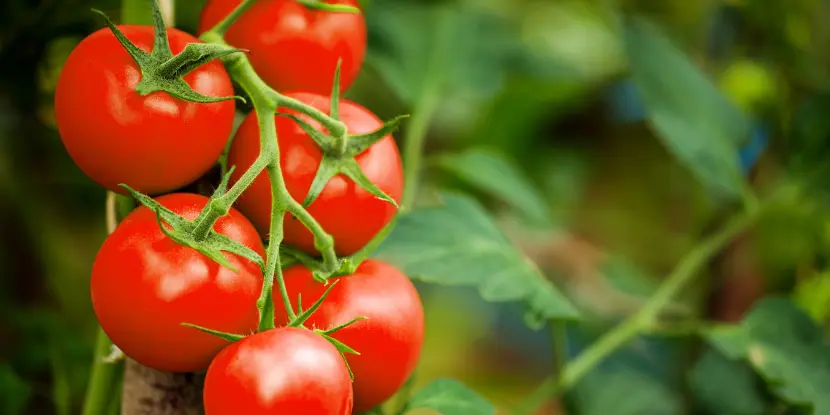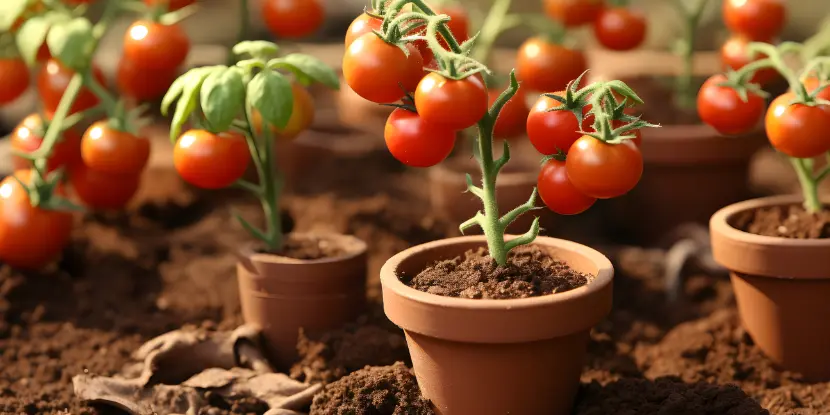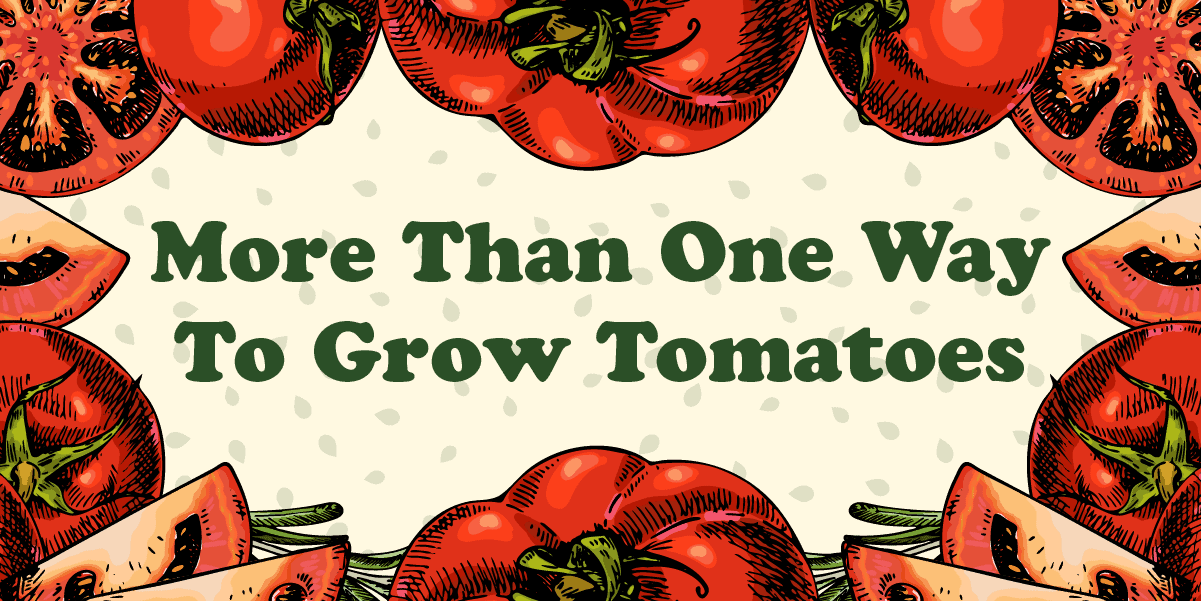Since most gardeners produce tomatoes, there’s no shortage of opinions about the best methods to grow them. Below, we cover a few important facts to ensure a good crop.
Tomato plants need moist soil with good drainage within a pH of 5.5 to 7.5. It should have high organic matter, medium nitrogen, high phosphorus, high potassium, and good air circulation. Are your garden soil and location suitable for tomato production?
Tomato Varieties
Tomato plants are either bush or vining; the latter usually have the best flavor. Bush types form their tomatoes as the stem tips, at which point the plants stop growing.
The fruit matures during a 30 to 40-day harvest season. Vining types form their tomato clusters along the stems, continue to grow, and develop more fruit if conditions remain favorable.

A cluster of ripe red plum tomatoes.
Do you prefer tomatoes for cooking, stuffing, slicing, salads, snacks, canning, or juice? Do you like a short harvest season or one that lasts from late spring to late fall?
Variety is a significant factor in productivity.
Varieties that develop large fruit include:
- Bingo
- Carnival
- Bush Celebrity
- Champion
- Homestead 24
- Merced
- Miracle Sweet
- Solar Set
- Spitfire
- Sunmaster
- Super Fantastic
- Surefire
- Terrific
Medium size varieties include:
- Bush Early Girl
- Dona
- Enchantment
- Heatwave II
- Porter’s Pride
- Tuscany
- Viva Italia
Cherry varieties include:
- Bush Cherry
- Cherry Grande
- Gardener’s Delight
- Porter, Small Fry
- Sweet Chelsea
- Sweet Million

Ripe tomato plant growing in greenhouse.
Growing Tomatoes in the Garden
- Dig a hole about 1 foot wide and deep for your planting site. Place compost and organic matter or fertilizer in the bottom half of it.
- Plan to support the plants so that tomato fruit won’t touch the soil. Cages are the most common means of support.
- When the soil is cool, set plants 2 to 3 inches deep in early spring. Roots will sprout along the stem and develop a more vigorous plant if most of the plant is in a trench with the top cluster of leaves turned up. Trim off any leaves along the horizontal stem. Once the soil warms, plantings can be set about 6 inches deep.
- Set plantings 2, 3, or 4 feet apart with 6 feet between rows. Closer is too crowded!
- Set 2 or 3 plants in the same hole or within a cage. This technique helps the plants mature earlier.
- Set plants next to solid stakes driven into the ground. Tie stems to the stakes and prune the plants. Early pruning will encourage the fruit mature about two weeks earlier.
- Mulch with dark colored-material during the cool spring and late fall.
- For top production, after plants develop their first cluster of fruit, use additional fertilizer every week in sandy type soil or every 10 days in clay soil.
The Container Watering Method
- Bury containers (planter pots or gallon jugs with large holes) between the tomato plants.
- Apply one tablespoon of ammonium sulfate to each container.
- Fill and refill containers within a one-hour window until the soil is saturated and the mixture has soaked into the root zone.
- Or, as an alternative, apply one tablespoon of a tomato-type fertilizer with a 1-2-2 ratio to each plant. Spread the mixture over the soil about 6 inches from plant stems when plants are young and about 12 inches from stems when plants are mature. Scratch the mixture into the topsoil.

Cherry tomatoes planted in terra cotta pots.
Pollination
The flowers on tomato plants are self-pollinating. Insects or vibrations can cause pollen transfer. Native bumblebees are the primary pollinators. Otherwise, shake the tomato plants every other day to pollinate.
What Not to Do
Avoid too much nitrogen, which will make plants grow too fast and become extra-large. Oversized tomato plants will develop little fruit, and the fruit they do develop will be watery and bland.
Sample Planting Schedule
- I purchased a six-pack of small tomato plants and transplanted them into 3 1/2 inch peat pots.
- Two weeks later, I set one plant in a 5-gallon bucket, supported by a cage, and another plant in a 5-gallon bucket next to a 6-foot stake.
- I transplanted the other four tomato plants into the garden within the next few days.
About Dr. Elmer Krehbiel
Dr. Elmer Krehbiel served as an extension educator at Oklahoma State University until 1992. He trained in 1993 as a Master Gardener in Comanche County, Lawton, Oklahoma, and transferred to Brazos County, TX, in 1994.
In 2005, he received an Honorable Mention as Texas Master Gardener of the Year.
In 1996, he began writing a weekly news column for The Eagle newspaper, composing more than 680 articles, earning a reputation as the “go-to man” for vegetable gardening. Elmer authored the Brazos County Vegetable Planting and Variety Guide, the single most requested publication from Brazos County Extension.
FAQs: Growing Tomatoes in Southern California
Q: What’s the best time to plant tomatoes in Southern California?
Plant your tomatoes in late winter or early spring as soon as the last frost has passed, typically from February through April.
Q: What type of tomato grows best in Southern California?
Heirloom varieties like Brandywine and beefsteak tomatoes thrive in SoCal’s climate, as do cherry tomato varieties for gardeners with limited space.
Q: How much sunlight do tomato plants need?
Tomato plants require at least 6 to 8 hours of sunlight daily. More sunlight encourages more robust growth and better fruit production.
Q: Do tomatoes need special soil?
Tomatoes prefer well-drained, fertile soil with a pH level between 6.2 and 6.8. Amending your soil with compost can improve soil fertility and structure.
Q: How often should I water my tomato plants?
Water deeply 1 to 2 times a week, allowing the soil to dry out slightly between watering. The frequency should increase during particularly hot or windy periods.
Q: What’s the recommended spacing for tomato plants?
Space tomato plants about 24 to 36 inches apart to allow air circulation and room to grow.
Q: How can I prevent pests and diseases in my tomato plants?
Maintain healthy soil, rotate crops annually, remove affected leaves, and use organic pest control measures as needed.
Q: When are tomatoes ready to be harvested?
Tomatoes are ready to harvest when firm and fully colored. The exact timing depends on the variety and the weather during the growing season.
Q: How can I increase tomato yield?
Choose high-yielding varieties, ensure adequate sunlight and water regularly, and provide support with stakes or cages to encourage growth.
Q: Can I grow tomatoes in containers?
Yes. Choose a container that’s at least 5 gallons in size and has good drainage. Make sure container-grown tomatoes are watered more frequently.

